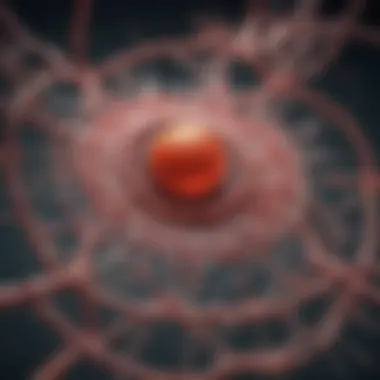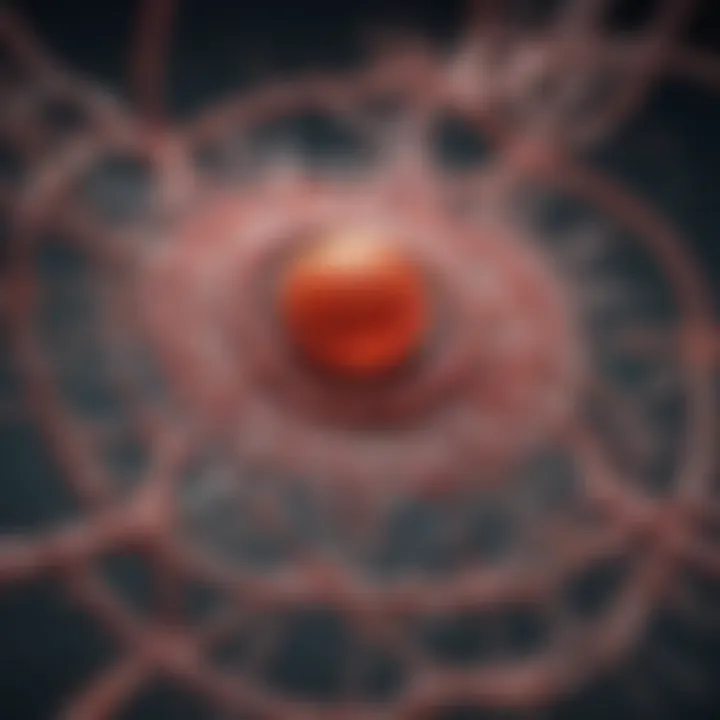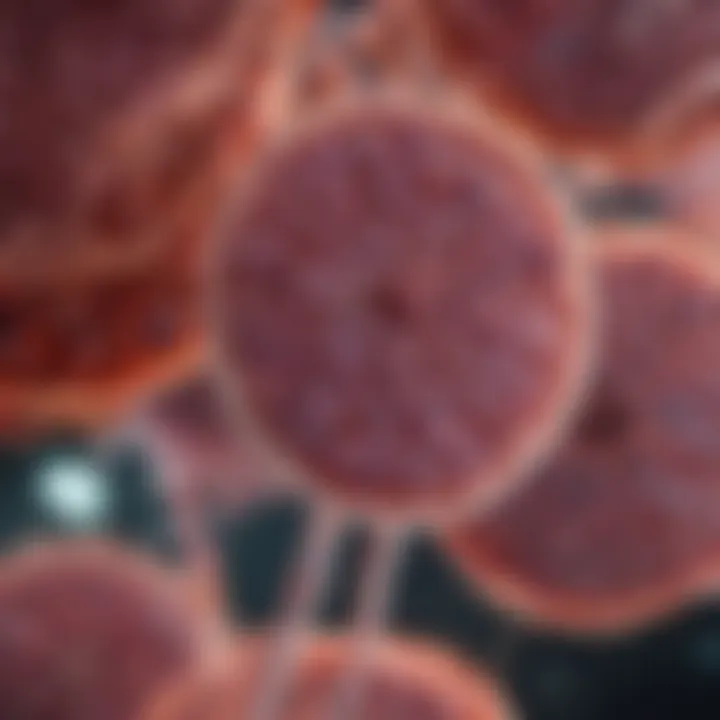Understanding Autologous Transplantation: Key Insights


Intro
Autologous transplantation is a significant and evolving field within modern medicine. It involves the transfer of cells or tissues from one site to another within the same individual's body. This process has profound implications across various specialties, including hematology, orthopedics, and dermatology. Central to autologous transplantation is the principle of immunological compatibility, allowing for the successful transfer of cells without the risk of rejection that is commonly associated with allogeneic transplants.
In understanding this complex procedure, one must consider the mechanisms that underpin it, the diverse applications that have emerged, as well as the future directions that this field is poised to explore. This article aims to provide a comprehensive overview of these elements, elucidating the clinical relevance and impact of autologous transplantation on patient care and outcomes.
Preamble to Autologous Transplantation
Autologous transplantation is a crucial aspect of modern medical treatments. It revolves around the idea of using an individual’s own tissues or cells, leveraging the body’s natural ability to heal itself. This practice significantly reduces complications often associated with donor transplants, such as rejection and graft versus host diseases.
This section will provide readers with a foundational understanding of what autologous transplantation encompasses. By laying out a clear definition and examining its historical significance, this article seeks to inform both medical professionals and informed readers on the relevance of this technique.
Definition and Scope
Autologous transplantation, simply put, is the process of transferring cells or tissues from one site of the body to another. This approach contrasts with allogeneic transplantation, which involves tissues from a different individual. The primary reason behind preferring autologous methods is the associated reduction in the risk of immune rejection.
The scope of autologous transplantation spans various medical fields, including hematology, orthopedics, and plastic surgery. Procedures like hematopoietic stem cell transplantation are pivotal in treating conditions such as leukemia and lymphoma. Furthermore, skin grafts are essential in managing severe burns. The versatility of this procedure makes it a valuable tool in regenerative medicine and therapeutic treatments.
Historical Context
The roots of autologous transplantation can be traced back centuries, though it has evolved significantly over time. Early techniques were rudimentary, relying heavily on empirical knowledge gained through trial and error. It was not until the mid-20th century that scientific advancements began to formalize the principles behind tissue transplantation.
In the 1950s, the concept of using one’s own body for surgical repairs took a leap forward. Research conducted by pioneers revealed that using autologous tissues led to better outcomes in numerous conditions. By the 1970s, autologous skin grafting became standard practice, providing surgeons with effective tools for treating burn victims.
The historical evolution shows a steady progress from rudimentary practices to the sophisticated, nuanced approaches we observe today. With advancements in biotechnology and surgical techniques, the potential for future applications continues to grow. This context sets the stage for the detailed exploration of mechanisms and applications of autologous transplantation in the sections that follow.
Mechanisms of Autologous Transplantation
Autologous transplantation is distinguished by its reliance on the same individual for both the extraction and reintegration of cells or tissues. Understanding the mechanisms underlying this process is crucial, as they directly influence the efficacy and safety of medical procedures. The mechanisms include a detailed sequence of operations encompassing cell extraction, preservation, and reintegration. Each step significantly contributes to the overall outcome and has specific considerations that impact patient health and recovery.
Cell Extraction Process
The cell extraction process serves as the initial step in autologous transplantation. This procedure essentially involves obtaining cells or tissues from a donor site within the same individual. For instance, in hematopoietic stem cell transplantation, stem cells are often harvested from the peripheral blood or bone marrow.
Key factors in the extraction process include:
- Site selection: The choice of extraction site can influence the quality and quantity of the cells. Common sites are the bone marrow for stem cells and adipose tissue for fat grafting.
- Techniques used: Various techniques like bone marrow aspiration or liposuction for fat extraction are employed. These methods must be optimized to minimize discomfort and tissue damage.
- Pre-procedural assessment: Adequate evaluation of the patient’s health is essential to prevent complications during extraction.
This phase is foundational, as the success of subsequent stages relies on the integrity and viability of the cells extracted.
Preservation Techniques
After extraction, the preservation of cells or tissues becomes vital. Proper preservation ensures that the integrity of cells is maintained during storage. This step is particularly important if immediate reintegration is not possible. Common preservation techniques include cryopreservation, which involves cooling biological samples to very low temperatures.
Important considerations in preservation techniques involve:
- Cryoprotectants: Substances such as dimethyl sulfoxide (DMSO) are often utilized to protect cells from damage during the freezing process.
- Storage conditions: The temperature and environment where cells are stored can affect their viability. Typically, cells are preserved at -80 degrees Celsius or in liquid nitrogen for long-term storage.
- Duration of storage: Cells can often be stored for extended periods, but the longer the duration, the greater the risk of losing viability and functionality.
Overall, appropriate preservation techniques are essential to ensure that extracted cells can be effectively used during reintegration.
Reintegration of Cells or Tissues
The final step in the mechanism of autologous transplantation is reintegrating the preserved cells or tissues back into the patient’s body. This step is critical, as it determines how well the body accepts the implant and the ultimate success of the procedure.


Considerations for reintegration include:
- Site for reintegration: The choice of location for reintegration must be suitable for the type of cells or tissues involved. For example, reintegrating adipose tissue requires different strategies compared to stem cells.
- Timing: The timing of reintegration plays a critical role in the healing process. Procedures should be well planned to optimize recovery and integration into the surrounding tissue.
- Monitoring and follow-up: Continuous observation after reintegration is essential to assess the success of the transplant and manage any potential side effects or complications.
In summary, the mechanisms of autologous transplantation encompass a series of meticulously planned steps that significantly influence clinical outcomes.
Understanding these mechanisms allows medical professionals to enhance techniques and improve patient prognosis during the autologous transplantation journey.
Clinical Applications of Autologous Transplantation
Understanding the clinical applications of autologous transplantation is central to comprehending its significance within modern medicine. The ability to utilize a patient’s own cells and tissues holds a myriad of benefits—ranging from reduced risk of rejection to faster recovery times. This approach minimizes complications often associated with donor-derived transplants, thereby making it a preferred choice in various medical contexts. Clinical applications cut across numerous specialties, including hematology, burn treatment, orthopedics, and aesthetic surgery. Each of these areas leverages autologous transplantation in ways tailored to address specific medical needs and patient outcomes.
Hematopoietic Stem Cell Transplantation
Hematopoietic stem cell transplantation (HSCT) is one of the most established applications of autologous transplantation. This procedure involves the harvesting of stem cells from the patient's bone marrow or blood, which are then used to restore bone marrow function after intensive treatments, such as chemotherapy or radiation. The primary advantages of HSCT include:
- Enhanced Recovery: Patients experience improved recovery times compared to allogeneic transplants (transplant from a donor).
- Reduced Graft-Versus-Host Disease (GVHD): Since the cells are the patient’s own, the risk of the body rejecting the cells or experiencing adverse immune responses is significantly lower.
The process is critical for patients with certain cancers and other bone marrow disorders. Additionally, research into HSCT continues to evolve, exploring its applications even further in other disease contexts, such as autoimmune disorders.
Skin Grafts in Burn Treatments
Skin grafting is another well-known application of autologous transplantation, particularly in the management of severe burns. In this process, skin is harvested from an unburned area of the patient's body and transplanted onto the burned region. The benefits of autologous skin grafting include:
- Natural Integration: Grafts are less likely to be rejected since they come from the same individual.
- Improved Healing: The procedure supports faster and more effective healing, leading to better functional and aesthetic outcomes.
Recent advancements have looked at optimizing donor site healing and minimizing graft loss, which highlights the ongoing innovation in this field.
Cartilage and Bone Regeneration
Cartilage and bone regeneration is a rapidly advancing area within autologous transplantation. This application typically involves the use of cells harvested from the patient’s own cartilage or bone marrow to repair damaged tissues. Techniques such as microfracture and autologous chondrocyte implantation are noteworthy. The key points here include:
- Articular Cartilage Repair: Utilizing patients’ cells to regenerate cartilage, often due to injuries or degenerative conditions like osteoarthritis.
- Bone Healing: Enhancing recovery from fractures or reconstructive procedures through the application of bone grafts derived from the patient.
This area shows promise, with research focusing on improving scaffolding techniques for better tissue integration.
Autologous Fat Grafting
Autologous fat grafting has gained traction, particularly in cosmetic and reconstructive surgery. In this technique, fat is harvested from regions like the abdomen or thighs and then injected into areas lacking volume. The advantages include:
- Biocompatibility: Minimal risk of rejection due to the use of one’s own tissues.
- Versatile Applications: This method is used in facial rejuvenation, breast reconstruction, and contouring surgeries.
Moreover, studies demonstrate that this technique can support the viability of surrounding tissues, further enhancing aesthetic outcomes.
In summary, the clinical applications of autologous transplantation reflect a well-established, multifaceted approach to patient care. From hematology to burn management and aesthetic applications, the significance of this technique spans wide disciplines, showcasing its core role in regenerative medicine.
Benefits of Autologous Transplantation
Autologous transplantation has become a critical technique in modern medicine, particularly valued for its multitude of benefits. Understanding these benefits helps in grasping the broader implications of the procedure for patients and the healthcare system. The intrinsic connection between the donor and the recipient diminishes some of the complications associated with other forms of transplantation, such as donor-cell immunogenicity and rejection risks. Furthermore, the application of this technique spans several medical disciplines, each leveraging its unique advantages.
Reduced Risk of Rejection
One of the primary benefits of autologous transplantation is the significantly reduced risk of rejection. Since the cells or tissues are sourced from the same individual who is receiving them, the chance of an immune response is minimized. Although the immune system is always vigilant, it tends to recognize its own tissues as self, thus reducing the likelihood of adverse reactions.


- Compatibility: With the donor and recipient being the same individual, there are fewer concerns regarding human leukocyte antigen (HLA) matching. HLA compatibility plays a crucial role in organ and tissue transplantation. In cases of autologous procedures, this is inherently assured.
- Long-term Outcomes: Studies have indicated that patients undergoing autologous transplants experience better long-term outcomes compared to those receiving allogeneic transplants. Lower rates of graft-versus-host disease (GVHD) further illustrate this benefit.
Immune System Compatibility
The compatibility of the immune system is another cornerstone benefit of autologous transplantation. This procedure takes advantage of the body’s natural immunological environment. By utilizing the patient’s own cells, clinicians can circumvent many of the complexities arising from immune system mismatches.
- Facilitated Healing: The body is often more prone to accept its own cells as they are already part of the individual's biological makeup. This acceptance leads to quicker and more effective healing processes.
- Less Intensive Immunosuppression: In contrast to allogeneic transplants, where immunosuppressants are routinely administered to prevent rejection, autologous transplants typically require fewer or no immunosuppressive drugs. This can improve the patient’s overall health and reduce the side effects associated with these medications.
Shorter Recovery Time
Shorter recovery time is also a notable advantage of autologous transplantation. Patients often experience faster rehabilitation following their procedures, which contributes to an enhanced quality of life post-transplant.
- Less Surgical Trauma: The extraction and reintegration processes can often be less invasive compared to allogeneic transplantations. A simpler procedure can lead to less pain and recovery time.
- Faster Return to Normal Activities: Patients generally return to their daily routines quicker, allowing them to engage in work and social activities sooner than those undergoing other forms of transplantation.
"The benefits of autologous transplantation not only enhance patient outcomes but also promote resilience in the healing journey by utilizing the body’s inherent properties."
Challenges in Autologous Transplantation
Understanding the challenges in autologous transplantation is crucial for improving outcomes and advancing the techniques involved. This section will address some key issues that can complicate the process, including potential complications, limitations in tissue availability, and patient-specific variations.
Potential Complications
Autologous transplantation, while generally safer than allogenic methods, is not immune to complications. The risks can vary depending on the specific type of transplantation performed. Common complications include infection at the site of cell extraction or reintegration. Hemorrhaging may also occur, particularly if surgical procedures are involved. Another significant concern is graft-versus-host disease (GVHD), although this is more typical in allogenic transplantation. In some cases, the extracted tissues may fail to thrive or integrate properly into the host area, leading to inadequate healing or functional restoration. Evaluating and mitigating these risks is essential for ensuring the success of the procedure and minimizing the burden on patients.
Limitations in Tissue Availability
The success of autologous transplantation heavily relies on the availability of suitable tissues or cells. In some instances, patients may have compromised tissues due to age, disease, or prior surgeries. For example, elderly patients may have less viable stem cells, which can hinder hematopoietic stem cell transplantation. Additionally, patients with obesity or metabolic disorders might pose a challenge for autologous fat grafting. The extraction of sufficient healthy tissue is vital for a successful outcome, and healthcare providers may face significant hurdles when sourcing these materials.
Patient-Specific Variations
Each individual's unique biology can complicate the process of autologous transplantation. Factors such as genetic background, overall health condition, and tissue characteristics play a role in the effectiveness of the therapy. For instance, differences in healing capacity among individuals may affect recovery times and the success of reintegrated tissues. Moreover, variability in immune response may also lead to unpredictable outcomes. These patient-specific variations necessitate a tailored approach to treatment, which can make planning and execution more complex. Understanding these differences is key to optimizing outcomes in autologous transplantation.
Autologous transplantation presents a series of challenges that require careful consideration and personalized strategies to enhance efficacy and minimize risks.
Addressing these challenges can lead to improved practices in autologous transplantation, which may ultimately benefit patients and medical practitioners alike.
Regulatory and Ethical Considerations
The regulatory and ethical aspects of autologous transplantation are crucial in ensuring the safety and efficacy of the procedure. As this field evolves, it faces increasing scrutiny from regulatory bodies, practitioners, and the public. Proper regulation is essential to protect patients and ensure that clinical practices are aligned with observed ethical standards. Understanding these components can foster confidence in autologous transplantation as a transformative medical practice.
Regulatory Frameworks
Regulatory frameworks serve as the backbone of medical ethics and safety in autologous transplantation. These guidelines are often established by governmental agencies and professional societies, which set the standards for procedures, materials used, and clinical outcomes. For instance, the United States Food and Drug Administration (FDA) monitors the use of biological products, including autologous cells. Adherence to these regulations helps ensure that the techniques employed meet scientific standards and the necessary quality controls.
Key points regarding regulatory frameworks include:
- Verification of techniques and outcomes: Regulatory bodies assess the efficacy of treatment methods and the associated risks.
- Mandatory reporting: Practitioners are often required to report adverse events or outcomes, contributing to the broader knowledge base.
- Approval processes: New methods or technologies must pass through rigorous evaluations before clinicians can implement them. Some products, like those derived from stem cells, may undergo additional scrutiny.
By establishing a well-defined regulatory environment, stakeholders help ensure that patients receive safe and effective treatment options.
Informed Consent Process
Obtaining informed consent is a fundamental ethical requirement in autologous transplantation. This process involves adequately informing the patient about the procedure, including its potential benefits, risks, and alternatives. Clear communication is essential to allow patients to make knowledgeable decisions regarding their care.


The informed consent process typically consists of:
- Explanation of the procedure: Patients should understand what the transplantation involves from start to finish.
- Discussion of risks and benefits: Practitioners must transparently outline the possible complications alongside the anticipated outcomes.
- Opportunity for questions: Patients should feel comfortable asking questions to clarify any uncertainties.
- Voluntary agreement: Consent must be given without coercion, ensuring it is a voluntary decision by the patient.
Ensuring patients fully grasp the implications of their choices supports ethical medical practice and reinforces the trust between healthcare providers and recipients.
Ethical Dilemmas in Practice
Despite the established frameworks and consent processes, ethical dilemmas frequently arise in the practice of autologous transplantation. Some common issues include:
- Equity in access: There is concern about whether all patients have equal access to this treatment option, particularly in lower socio-economic groups.
- Commercialization concerns: The commercialization of autologous therapies raises questions about profit motives potentially overshadowing patient care.
- Patient autonomy vs. physician guidance: While patient autonomy is vital, there are instances where a patient's understanding of the risks may be limited. Striking a balance between respecting autonomy and ensuring patient safety can be challenging.
"Ethical considerations in medicine cannot exist in isolation. They require continuous evaluation as the field adapts and advances."
Addressing these dilemmas necessitates ongoing dialogue among patients, healthcare practitioners, and policymakers. It is imperative to foster an environment where ethical discussions are encouraged, helping navigate the complexities of autologous transplantation.
These regulatory and ethical considerations serve as a foundation for the advancements in autologous transplantation. By ensuring safety, providing information, and engaging in ethical reflection, stakeholders can contribute positively to this evolving medical field.
Research and Innovations in Autologous Transplantation
Research in autologous transplantation is vital to enhancing patient outcomes and expanding applications within medicine. The focus now is on harnessing superior techniques to improve cell extraction, preservation, and reintegration. Innovations arise from interdisciplinary collaboration, aiming for more successful transplant procedures while minimizing complications. With ongoing studies, autologous transplantation continues to evolve significantly, delivering insights into cellular behavior and the technology that accompanies it.
Emerging Technologies
Innovative technologies are reshaping how autologous transplantation is performed. Three technologies gaining momentum include:
- 3D Bioprinting: This allows for the creation of complex tissue structures, which may be used for grafts. The precision this method offers could lead to more personalized solutions for patients.
- Stem Cell Niche Engineering: Findings concerning the microenvironment that supports stem cells are critical. By recreating these niches, researchers hope to enhance cell survival rates and function post-transplant.
- Gene Editing Techniques: With CRISPR and similar technologies being adapted for cellular therapies, we can potentially correct genetic disorders before reintegration. This approach may offer chronic disease patients new avenues for treatment.
These technologies can lead to improved results and might change long-term outcomes and therapies in various medical fields.
Advancements in Cellular Engineering
Cellular engineering serves as an important frontier in autologous transplantation. Adjustments in cellular characteristics and behavior may significantly impact transplant efficacy. Various advancements include:
- Induced Pluripotent Stem Cells (iPSCs): Researchers are converting adult cells into iPSCs, which can differentiate into any cell type. This can produce a virtually unlimited source of cells, alleviating the demand for durable tissues.
- Targeted Delivery Systems: Innovations in how cells are administered to the target sites can streamline recovery processes. By developing these systems, scientists can enhance tissue integration and functionality post-transplant.
- Biomaterials: New biodegradable materials support cell growth and integration within host tissues. Using these materials improves healing and provides structural support to transplanted cells.
These advancements are notable for potentially overcoming the significant challenges currently faced in the application of cellular therapies.
Future Directions and Potential
The future of autologous transplantation appears promising, driven by ongoing research and innovative breakthroughs. The next steps include:
- Personalized Medicine: As we learn more about the genetic makeup of individuals, tailored treatments could become the norm. Adapting transplant procedures to each patient's unique profile can lead to better success rates.
- Longitudinal Studies: Continuous research observing long-term outcomes of various protocols will be crucial. We need accurate data to refine practices and assess the effectiveness of new techniques.
- Integration with Regenerative Medicine: Combining autologous transplantation with regenerative medicine practices may open up new avenues for treatment, allowing for comprehensive repair of damaged tissues.
In summary, the landscape of autologous transplantation is changing rapidly. Researchers are optimistic in paving the way for innovative solutions that will significantly impact patient care.
"Advances in technology are not just incremental; they have the potential to redefine what is possible in autologous transplantation."
Further exploration of these points will enlighten readers about the trajectory of this field and its implications for future medical practices.
Closure
The conclusion of this article encapsulates key elements and insights regarding autologous transplantation. This medical technique, which entails the transfer of cells or tissues within an individual’s body, holds significant importance in therapeutic contexts. The overarching benefits, including reduced risk of rejection and enhanced compatibility with the immune system, make this approach especially appealing in various clinical scenarios.
Summary of Key Points
- Definition and Importance: Autologous transplantation provides a solution that minimizes complications associated with donor tissues.
- Mechanisms and Processing: The steps involved in cell extraction, preservation, and reintegration maintain the integrity of tissues, which is essential for the success of the procedures.
- Clinical Applications: This technique is utilized in numerous fields, from hematopoietic stem cell transplantation to skin grafts and orthopedic surgeries.
- Benefits: Autologous transplantation significantly lowers the chances of rejection, offers compatibility with the recipient's immune system, and generally results in shorter recovery times.
- Challenges: Despite its advantages, this approach faces trials like potential complications and limitations in tissue availability.
- Regulatory and Ethical Considerations: Navigating the regulatory frameworks and ethical issues is paramount in ensuring responsible medical practice.
- Future Directions: Ongoing research and technologies continue to innovate this field, promising novel applications and improved outcomes.
Final Thoughts on Future Prospects
Looking ahead, the future of autologous transplantation is promising. Advancements in cellular engineering and emerging technologies are paving the way for broader applications. The potential to refine the extraction and reintegration processes presents an opportunity to enhance patient outcomes and expand clinical uses. Moreover, innovations in regulatory frameworks can facilitate research while ensuring ethical considerations. It is crucial that stakeholders remain engaged in interdisciplinary dialogues to address these challenges and propel future developments in this impactful medical area. As such, autologous transplantation stands at the nexus of existing practices and next-generation therapies, embodying a significant part of modern biomedical solutions.



